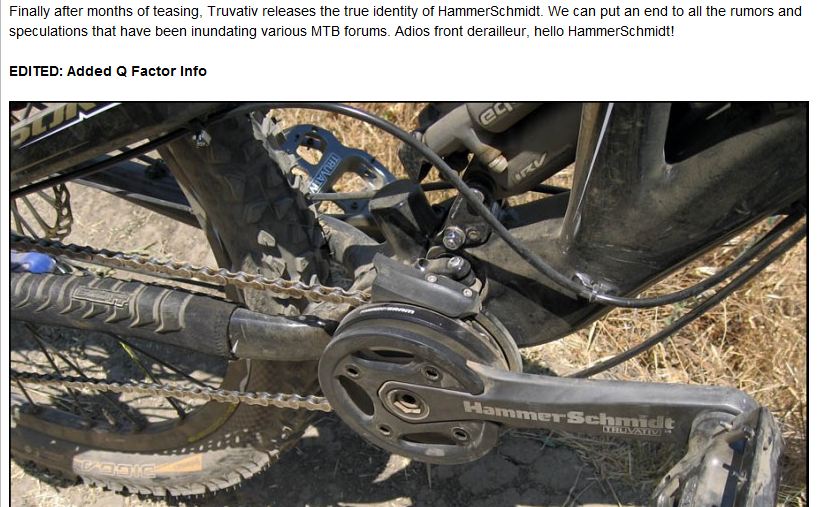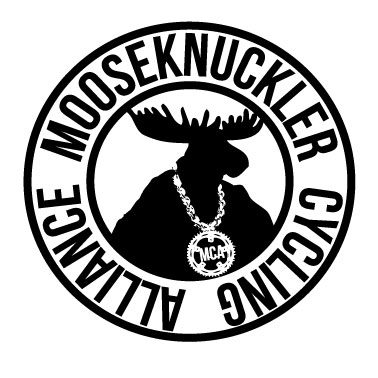I posted a bit back about how I felt the new ScRAM XX1 drivetrain was a step in the wrong direction with a capitalized and bolded WRONG. I was questioned as to why I thought it was moving in the wrong direction and since the release and buzz that has been created I have been asked by coworkers, customers and puppies about this new group. My first impressions were based on the youtube video that ScRAM had posted to debut their group and a few write ups found throughout the interwebs.
Well, since then I took some time and investigated, found new info and re-analyzed the whole damn thing. And I decided that I still think it is a bad idea…
First up, let’s take a look at the history.
In 2008 ScRAM, a.k.a. Truvativ, released the Hammerschmidt. This was supposed to be the end of front derailleurs, that one missing link that everyone had been waiting for to shed the clanky device and move into the 21st century. The Schmidt came and the Schmidt went. When was the last time you thought about this device? I’m not going to lie to you, I just searched QBP to see if they were even still available.

Well, the long and short of it is that it didn’t spell the end of derailleurs. It was heavy. It required expensive milling tools to install and when it was all said and done, it added an extra clicking sound to your drivetrain and more drag. Did it shift? Absolutely. Much in the same way that Alfine and Rholf hubs shift. They work, but they are heavy.
Next up in our history lesson is the release of XX. The well working 3X9 system was to be abolished by the perfect, lightning fast shifting of the new 2X10 system that ScRAM was to release. It was light. It looked fast. And yes, the 2X setup shifted better than a 3X. It has long been accepted wisdom on the road front that doubles shift better than triples.
Now a few years later, they have eliminated all the shifting in the front and are pushing a single chainring setup.
What does our history lesson teach us? ScRAM has no idea how to create a front derailleur that works. There is a reason that most OEM spec’d bikes don’t run ScRAM front derailleurs. They are flimsy, unreliable and look ugly (oh like you thought the aesthetic qualities of the hose clamp on the XX was awesome). Every mechanic will tell you that Shimano has the front shifting locked down. All of these “advancements” that ScRAM has been developing are really work arounds for their inability to get their front derailleurs to rock.
But let’s move past history and look at the XX1 on its own merits. In an effort to make this as logical and easy to follow as possible, I will follow ScRAM’s release that can be found here. If you would like to follow along as to where I am getting my info.
King of the Ring, well maybe. I’ve never been a fan of SRAM’s cranks, and these are no exception. They are the same technology that they have been using for a while with some small changes. They have a proprietary spider with a 76 BCD that mates to their chainrings. You will notice that their is an emphasis on the ease of swapping the rings. Why? Probably because the single ring set up is so specific that they expect people to want to change their shit often.
You may also notice that their rings come only in 2 tooth increments. This is so that there new X-sync technology can work. In an attempt to eliminate the need of a chain guide, they have machined the teeth to line up with the different widths of the chain. Narrower teeth for the inner links and wider teeth for the outer. This means that your chain has to be set on right the first time and if it falls off, make sure to put it back where it goes.
Yea, it’s available in BB30. I’m not even going to go there.
Ah, the X-Horizon rear derailleur (you’ve got to love all the marketing bull shit that has gone into this) is necessary to run the wide range of the 11 speed cassette. This is where I start having some pretty big issues. Watch the cage of the rear derailleur as it moves through its range. That spring is working over time. With the durability issues they’ve had in the past, I wonder what is going to happen the first time someone is really torquing and shifts through half the range of the cassette…
Again the wide range of the cassette is, in my opinion, where the problems will be found with this group.
For those of you who have had the misfortune of working on the Apex group, you probably noticed the struggle to use the big cog when in the big chainring. The bigger cog on the cassette exacerbates the effect of cross chaining. By throwing the 32 tooth cog on the Apex cassette, they made it necessary to run a longer chain stay (which no company to my knowledge has done) to accommodate the needed chain flex for that gear.
This is also evident on 2X10 systems running a 36 tooth chainring. The chain flexes at an extreme angle causing more noise, reduced shifting performance and faster chain wear. Yup, faster chain wear.
It is an often assumed that more gears means a thinner and less durable chain. When it really comes down to it, the chain isn’t stretching, the roller links are wearing out effectively elongating the chain. The more gears that you through at a drivetrain, the more the chain has to flex to get from one side of the range to the other. Those cross chained noises are the outer links wearing out the roller link, and yes “stretching” your chain.
A narrower chain is not by definition weaker. The outer links are the same, only the roller link and pin are narrower. So they chain should be just as strong…
In conclusion, I think this drivetrain epitomizes what is wrong with the current direction of the bicycle industry. It is a gimmick that will come and go. It will not make you ride faster. It will not make you sexier and it will not make you happy. In the long run, it will probably just make you poorer.
At least that is how I see it after a couple shots of Jameson.
For those of you who would prefer to make your own call, here are a few resources:
http://www.sram.com/sram/mountain/family/xx1
http://www.bikerumor.com/2012/07/07/hands-on-sram-xx1-1×11-group-details-pics-more/
And of course the video,
Out.

I never understood, technically speaking, the advantage of a 2X10 setup… You cross your chain a lot more and there’s a huge difference between your rings. I’ll keep my 3X9 transmission just for those reasons for as long as I can.
This reminds me of a few things that I never understood in the bicycle industry: about 15-20 years ago, crankarms were 170mm long and big rings had 42 teeth. A few years later, crankarms were 175mm and big rings had 44 teeth… Why? To me the only difference between the old and new is that 175mm long crankarms hurt my knees and I can’t find the right saddle height. Is this what we call progress?